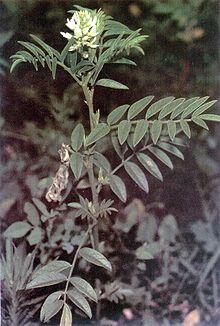Glycyrrhiza lepidota
| American licorice | |
|---|---|

| |
| Scientific classification | |
| Kingdom: | Plantae |
| Clade: | Tracheophytes |
| Clade: | Angiosperms |
| Clade: | Eudicots |
| Clade: | Rosids |
| Order: | Fabales |
| Family: | Fabaceae |
| Subfamily: | Faboideae |
| Genus: | Glycyrrhiza |
| Species: | G. lepidota
|
| Binomial name | |
| Glycyrrhiza lepidota (
Nutt.) Pursh | |
Glycyrrhiza lepidota (American licorice) is a species of
The plant grows in moist soils; although it will grow in heavy soil it prefers sandy soil. It grows to 40–100 cm (16–39 in) tall, and has long tough brown roots which are said to be sweet and were used as food and for

American licorice is not sweet from sugar but from glycyrrhizin. Glycyrrhizin may increase blood pressure (aka hypertension) by interfering with cortisol conversion. The Zuni people chew the root to keep the mouth sweet and moist.[6]
American licorice is grazed by cattle, but not preferred and will increase under grazing as competing plants are grazed off. The new growth can be toxic.[7] It has light green to white flowers in the spring which ripen in the fall to clusters of burs which contain pods of small bean-like seeds.
It can be used as a
There is a market for American licorice root both for medicinal uses and flavoring; also the sweetening of tobacco products.[1]
References
- ^ LCCN 2004380541.
- ISBN 1-55054-703-8.
- ISBN 0-88864-298-9.
- OCLC 19487479.
- ^ Schiemann, Donald Anthony (2005). Wildflowers of Montana. Missoula: Mountain Press Publishing Company. p. 182.
- PMID 6893476.
- ^ "Glycyrrhiza lepidota". Plants for a Future. Retrieved 8 March 2017.
